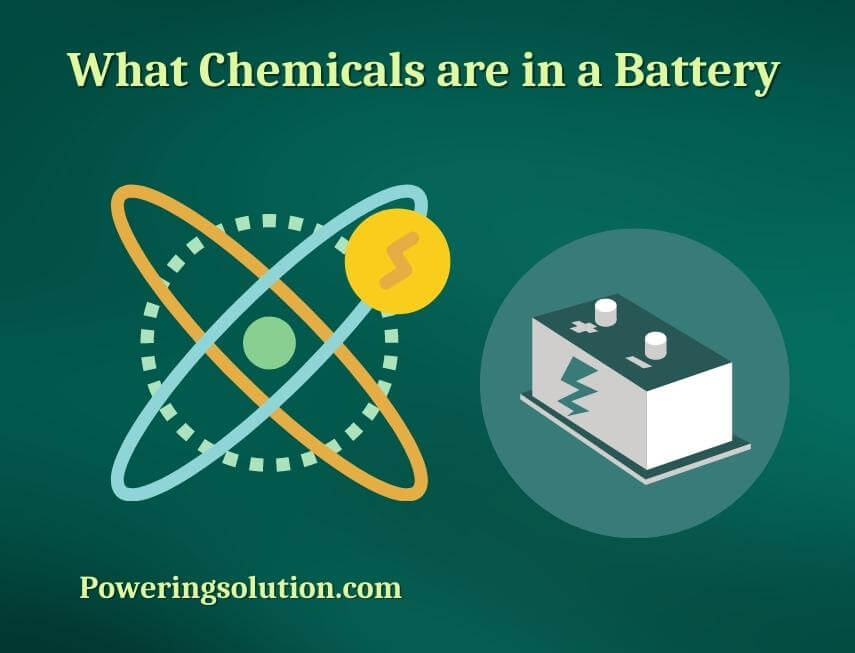In the unseen heart of our ubiquitous electronics lies a wonder of modern science – the humble battery. So, what chemicals are in a battery, turning it into a marvel of stored energy? Let’s find out.

What Chemicals are in a Battery?
First and foremost, let’s tackle the seed question: What chemicals are in a battery? Batteries consist of two electrodes—an anode (negative) and a cathode (positive)—and an electrolyte to catalyze the reactions. The types of chemicals vary, including lead, lithium, zinc, and more, each dictating the battery’s characteristics.
A Battery’s Lifeline: The Chemical Reaction
The essence of a battery lies in its chemical reactions. Energy gets stored as chemical potential energy, then converts into electrical energy. The type of chemical reaction in a battery defines its overall performance, lifespan, and environmental impact.
A Peek Inside Alkaline Batteries
Dive into the world of alkaline batteries, and you’ll find it teeming with chemical interactions. So, what are the primary components?
The Alkaline Trio: Zinc, Manganese Dioxide, and Potassium Hydroxide
The core components of an alkaline battery are zinc (anode), manganese dioxide (cathode), and potassium hydroxide (electrolyte). This trio forms a powerful alliance, making alkaline batteries a common choice for many applications.
The Chemistry of Lead-Acid Batteries
When you turn the key in your car’s ignition, it’s the trusty lead-acid battery that springs to life. So, what chemicals constitute this reliable power source?
Lead, Lead Dioxide, and Sulfuric Acid: The Power Behind the Ignition
Lead-acid batteries use lead (anode), lead dioxide (cathode), and sulfuric acid (electrolyte). The interaction between these components offers high surge currents, perfect for cranking your car engine to life.
Lithium-Ion Batteries: The Power Behind Your Smartphone
Lithium-ion batteries are the heart of our modern digital life, powering everything from smartphones to laptops. But what’s their chemical makeup?
The Lithium Legacy: Lithium, Lithium Cobalt Oxide, and a Lithium Salt
The star of the show in these batteries is lithium. The typical composition includes a lithium anode, a lithium cobalt oxide cathode, and a lithium salt in an organic solvent as the electrolyte.
Nickel-Cadmium (NiCd) and Nickel-Metal Hydride (NiMH) Batteries
NiCd and NiMH batteries are popular in power tools and hybrid vehicles, each with their unique chemical configuration.
Nickel and Cadmium: The Dynamic Duo
In a NiCd battery, the cathode is made of nickel hydroxide, and the anode consists of cadmium. The electrolyte is usually a solution of potassium hydroxide. Despite the toxicity of cadmium, these batteries provide exceptional discharge rates and performance in cold temperatures.
Nickel and Metal Hydride: A Safer Alternative
Nickel-Metal Hydride (NiMH) batteries, on the other hand, replace cadmium with a metal hydride as the anode. This swap makes them a safer, albeit less powerful, alternative.
Zinc-Carbon Batteries: The Classic Choice
Zinc-carbon batteries, also known as “standard” batteries, have been around since the 19th century. What chemicals have made them stand the test of time?
Zinc, Manganese IV Oxide, and Ammonium Chloride: The Time-Tested Trio
In a zinc-carbon battery, zinc serves as the anode, manganese IV oxide as the cathode, and a paste of ammonium chloride as the electrolyte. Despite their lower energy density, they remain popular for low-drain devices due to their cost-effectiveness.
The Eco-friendly Option: Rechargeable Batteries
As we strive for sustainability, rechargeable batteries have become increasingly significant. But what are the chemicals that allow these batteries to be recharged?
The Chemistry of Rechargeability
Rechargeable batteries, like their lithium-ion or nickel-based counterparts, leverage reversible chemical reactions. In these batteries, both the discharge (provides power) and charge (restores power) processes involve the transformation of chemical energy.
FAQs
What chemicals are in a battery?
The chemicals in a battery can include a range of materials, from lead and sulfuric acid in a lead-acid battery, zinc and manganese dioxide in an alkaline battery, to lithium and cobalt in a lithium-ion battery.
Are the chemicals in batteries harmful?
Some batteries, like lead-acid and nickel-cadmium, contain harmful chemicals like lead and cadmium. These can be hazardous if the battery leaks or is improperly disposed of.
How do the chemicals in a battery work?
The chemicals in a battery participate in chemical reactions, transforming chemical energy into electrical energy. This process involves the movement of ions between the anode and cathode via the electrolyte.
What chemicals are in a rechargeable battery?
The chemicals in a rechargeable battery depend on the type. Lithium-ion rechargeable batteries use lithium, cobalt, and a lithium salt, while nickel-metal hydride batteries use nickel and a metal hydride.
Can the chemicals in a battery be replaced?
While theoretically possible, replacing the chemicals in a battery is typically impractical due to the complexity and cost. It’s usually more efficient to recycle or properly dispose of the battery.
Are there eco-friendly battery options?
Yes, there are more eco-friendly battery options like nickel-metal hydride batteries and newer lithium-ion batteries designed with safer, less toxic materials.
Conclusion
As we’ve unraveled, a battery is a cocktail of chemicals, each with a unique blend, depending on the battery type. From our everyday alkaline batteries, the reliable lead-acid car batteries, to the power-packed lithium-ion batteries, each harnesses specific chemical reactions to store and supply power. Indeed, the question “What chemicals are in a battery?” opens up a world of science and wonder in a package small enough to hold in your hand.
Read more:
